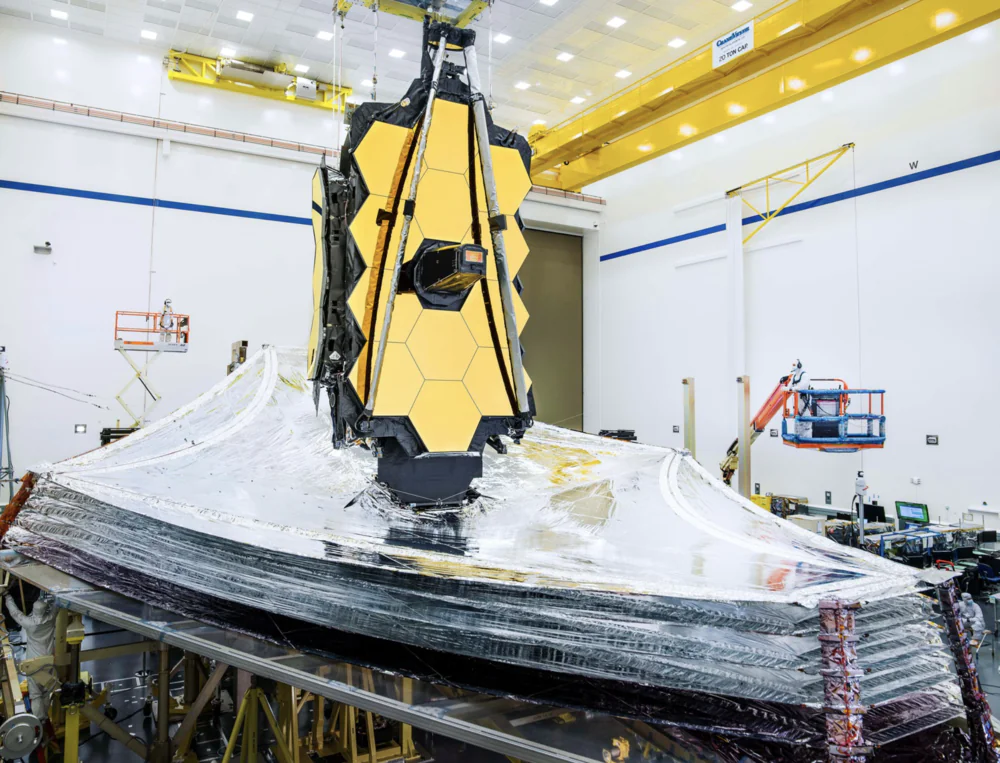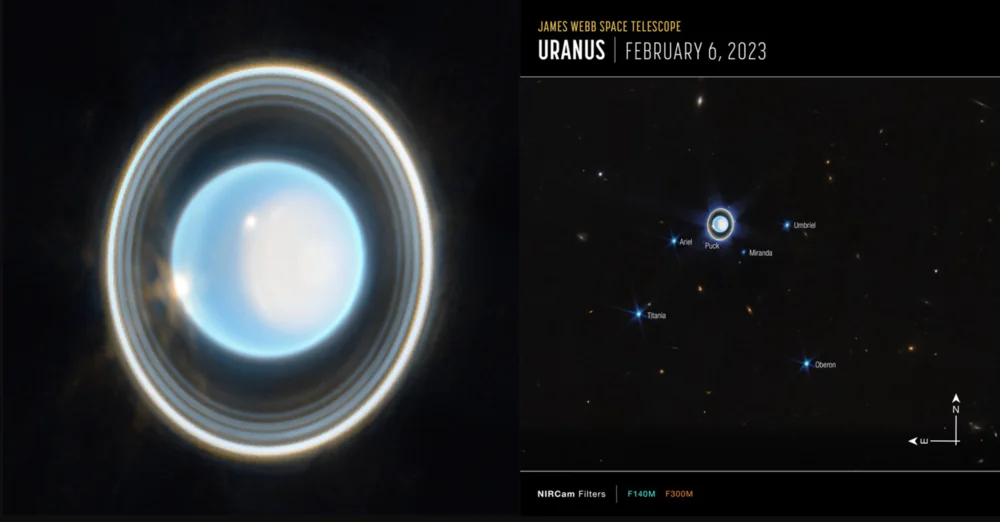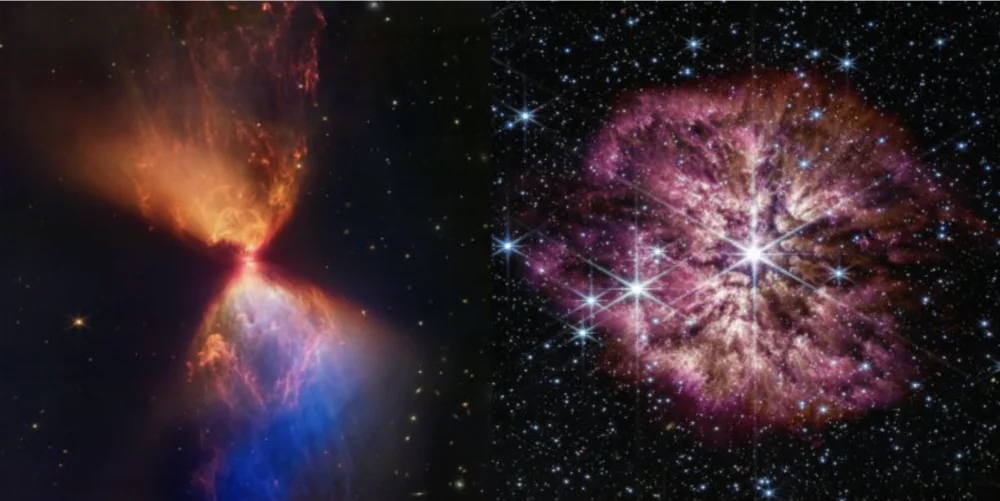© ROOT-NATION.com - Use of content is permitted with a backlink.
Exactly one year ago, astronomers released the first scientific images taken with the James Webb telescope, which caused euphoria among many people.
The months that followed also brought revolutionary photographs of the sky, each one pushing the boundaries of our knowledge of astronomy, enriching our understanding of the universe.
Don’t you get the impression that gradually we are hearing less and less about the Hubble Space Telescope, and mostly we are getting new messages related to James Webb’s observations? This is just an impression. But the fact is that the Hubble Space Telescope did not take images in the best resolution, and sometimes they were frankly blurry, so the iconic images (the Kiel Nebula, the Pillars of Creation, the area of star formation in the Small Magellanic Cloud) will now be much better. It is time for completely new projects, including observations in deep space. Therefore, we can write endlessly about the work of the James Webb Telescope. Of course, this does not mean that Hubble is gone, he is still working bravely in space, but the time has come for his successor.

We all remember the photo of James Webb’s telescope in a ground-based room with the sunshade deployed, the effectiveness of which determines its position in orbit around the L2 point. And now it is somewhere in the depths of the Universe exploring space and taking pictures of interesting objects.
New space telescopes will soon appear, but Webb will remain the best
Webb (officially JWST or James Webb Space Telescope) will have another companion in a few months in a neighbouring orbit around L2, 1.5 million kilometres from Earth – the Euclid Telescope for a large-scale survey of the sky, which will look for signs of dark energy and dark matter. In a few years, the Euclid will be joined by another telescope, the Nancy Grace Roman telescope, which will enter Earth orbit. However, it is James Webb that will remain the largest space telescope for a long time to come, with the best ability to see the details of both the nearest space (the solar system) and the farthest reaches of the Universe.
At the end of this year, there will be another special anniversary – 30 years of operation of the Hubble telescope after the “eye surgery”, i.e. the installation of an instrument that corrects the blurred image created by an improperly polished mirror. This was done in December 1993, more than three years after the telescope was launched into orbit.

The James Webb Telescope did not have such problems, and the performance of its instruments exceeded the wildest expectations of astronomers. Yes, it took a year for scientists and engineers to get through some initial moments of stress, as some elements associated with the MIRI instrument for mid-infrared observations failed twice (in the summer of 2022 and spring of 2023). So did the NIRISS instrument (winter 2023), whose problems were caused by cosmic rays.
Nevertheless, the investment in James Webb has paid off. According to official figures, the telescope cost $10 billion. This amount is comparable, for example, to the $13 billion that it costs to build the most modern aircraft carrier in the US Navy, the USS Gerald R. Ford. It’s not a perfect comparison, but it shows how the value of money differs between astronomy and military technology.
Read also: Google Bard AI: everything you need to know
What did the 12 months of telescope observations yield?
It is time to summarise the results of the year of observations, highlight the most interesting discoveries and show their impact on astronomy.
The benefits that Webb has given astronomers are the ability to see already known objects with even higher resolution and to see things that had previously eluded us. Thus, astronomers have obtained a lot of data that will allow them to improve existing theories or create new ones. Although it sounds very trivial, Webb’s achievements required the cooperation of engineers and scientists from all over the world.

Below is a collection of the most interesting images from the James Webb Space Telescope, obtained over 12 months of observations so far.
Read also: All about the new MuWNS navigation system: Works underground and underwater
From the nearest asteroids to the most distant black hole
The first comparative observations showed the value of being able to see the cosmos simultaneously in the near-infrared and in the mid-infrared, where much colder structures can be seen, barely visible in visible light. This is not only about the iconic Pillars of Creation, but also about observing objects in the solar system. James Webb’s telescope has already explored Jupiter and Saturn, and provided the best images of Neptune’s dust rings, as well as Uranus and its many moons. You can see how Webb’s telescope viewed Uranus and its rings in the expanded image with the largest moons marked:

In addition to the planets, the James Webb telescope also targeted Saturn’s moons, including the surface and clouds of Titan and icy Enceladus, where the emissions of ice, water vapour and organic compounds that form the torus around the planet were seen extremely well.
Webb also allowed scientists to observe the DART probe’s collision with the asteroid Dimorphos last autumn, and this year helped confirm the existence of a particularly rare category of comets originating from the asteroid belt between Mars and Jupiter. The smallest asteroids Webb has observed in that region are about 100 m in diameter.

We were interested in the observation of Comet Read by the Webb Telescope. It is very interesting for astronomers because it contains water. Although this should not be the case, given the comet’s orbit in the asteroid belt, which is much closer to the Sun than the orbits of comets beyond Neptune. There are more impressive visualisations and conclusions in the media, but astronomers are satisfied with the diagram above.
Astronomers have also pointed the telescope at extrasolar planets. In January, Webb’s telescope detected the first such planet, which looks like the Earth, although it orbits its Sun in a very narrow orbit with a period of two days. Thanks to infrared observations, James Webb was able to measure the temperature on the surface of the rocky planet Trappist-1 b and observed the dust disc around the young star AU Microscopii, which is undergoing a dynamic evolution after the planet’s formation. Each of these observations boasts the best data resolution ever. The Webb spectroscopes have also revealed unusual planetary atmospheres, such as the silicate atmosphere around the planet VHS 1256b.
The molecular cloud Chamaeleon I looks impressive in the photo:

In the case of stars, the Webb Telescope can reach areas where young stars will form in the future, such as the Chamaeleon I molecular cloud, where ice was detected, as well as numerous complex organic compounds indicating the formation of planets around stars, which could be the beginning of advanced life in the future. In the Orion Nebula, 1350 light-years away, the James Webb Telescope discovered the most complex compound, a methyl cation, the starting point for the formation of complex forms of carbon.
This is what the region of the Orion Nebula looks like where spectroscopists have detected the most complex carbon particle known outside the Solar System. Images from the NIRCam (near infrared) and MIRI (mid-infrared) cameras:

At the same time as observing the initial stages of star formation, such as L1527, the Webb telescope also observed the last stages of the life of stars, such as the massive and hot star Wolf-Rayet 124, which will eventually become a supernova. In both cases, previously invisible details of these objects were recorded.
Just take a look at these wonderful photos, where on the left is the formation, the birth of a star, and on the right is the final stage of an old star’s life:

Thanks to the MIRI mid-infrared instrument, among the many excellent images, you can also see the remnants of the supernova Cassiopeia A. Although they have been observed many times before, it was the Webb telescope that showed much clearer images. This will allow us to understand more about the processes that lead to supernova explosions, as they create matter similar to that from which the Earth was once formed.
Take a look at how the telescope saw Cassiopeia A. By the way, this nebula was seen using the MIRI mid-infrared cameras.

The Solar System and the Milky Way are the closest observational area of the Webb Telescope. Over the past year, the telescope has also observed other, much more distant galaxies, such as Andromeda or the Magellanic Clouds. And those in which it is possible to clearly observe details, such as dust bands in the galaxy NGC 1433, located at a distance of 46 million light years, and analyse the evolution of star clusters based on observations. And those that are billions of light-years away, for which we can only observe their silhouettes and general composition.
Really clear photos allow us to see the details of the dusty structure of the galaxy NGC1433 in the mid-infrared. The image was taken as part of the PHANGS (High Angular Resolution Physics in Nearby Galaxies) project.

However, even in the latter case, Webb’s range is better than any tool available to us today. It is precisely this state-of-the-art instrument that allows us to show structures that we have not seen before.
These include clusters of galaxies emerging in the early Universe, young galaxies that are just gaining matter from their first supernovae, and the most distant and one of the first galaxies in the Universe (300-500 million years after the Big Bang). These are structures in which stars are intensively forming and which already existed when the intergalactic spaces were filled with not yet fully ionised matter. We can see this stage, when the Universe slowly became transparent to light, in the images taken by the James Webb Telescope.
In observing these most distant objects, Webb is also assisted by nature, or more precisely, by the phenomenon of lensing. The most advanced example of this is the image of the Pandora supercluster (or Abell 2744), which contains numerous lensing galaxies from when the Universe was several hundred million years old. Compared to the Hubble telescope, deep space images from over 50,000 light sources can be obtained with an exposure that lasts a few hours rather than many days. This is a huge acceleration of observation.
The James Webb Telescope has captured the Pandora supercluster of galaxies in photographs. In the case of gravitational lensing, even the slightest increase in resolution is invaluable for modelling the phenomenon and estimating the actual distance of the lensed galaxies.

Thanks to his ability to observe groups of such early objects, Webb was able to detect the grain of cosmic structure. It consists of clusters of galaxies that are located in space, separated by voids (but in practice, these are not areas without matter). This research is being conducted as part of the Cosmic Evolution Early Release Science (CEERS) project, which has made it possible to observe the oldest black hole, which has already existed for 570 million years after the formation of our Universe.
Observations of distant black holes in the centres of galaxies are carried out using micro-aperture technology, which is several times thicker than a human hair and can be opened and closed. Thanks to this, Webb can observe the spectra of up to 100 galaxies simultaneously, which significantly speeds up the work and provides astronomers with huge amounts of data, most of which have not yet been analysed.

The spectra of several galaxies simultaneously obtained using microaperture technology. This may not seem very interesting to an amateur, but astronomers could write a whole book based on this picture alone.
 Below is a three-dimensional journey to the Maisie galaxy, which existed when the Universe was only 290 million years old. It shows the distance differences of up to 5000 galaxies in the small part of the sky observed by CEERS. Moving from the nearest galaxy to the Maisie, we go back in time by 200 million years.
Below is a three-dimensional journey to the Maisie galaxy, which existed when the Universe was only 290 million years old. It shows the distance differences of up to 5000 galaxies in the small part of the sky observed by CEERS. Moving from the nearest galaxy to the Maisie, we go back in time by 200 million years.

Anniversary photo – the star formation region of Rho Ophiuchi
“On its first anniversary, the James Webb Space Telescope has fulfilled its promise to discover the universe, giving humanity a fascinating treasure trove of images and science that will last for decades,” said Nicola Fox, NASA’s chief scientist, summing up the first anniversary of observations. And it’s hard to disagree with these words.
To celebrate its anniversary, the Webb Telescope has taken pictures of the star formation region of Ro the Serpent, one of the brightest areas of the Milky Way. Many of the stars there are still forming and hiding in the clouds of dust that dominate the orange-yellow region of the image. With the exception of one that managed to shine through the dust, the remaining 50 or so stars are similar to or smaller than the Sun.

Those stars that are somehow born are revealed to our eyes at the moment when, shining for the first time, they begin to scatter the surrounding matter.

This can be seen in the image as red and purple jets (streaks) of molecular hydrogen radiating in two directions from the location of the stars. Thanks to the James Webb Telescope, this is the first time such a large number of overlapping jets have been observed in this region.

The Roe of the Serpentine Nebula is located 390 light-years away in the constellation Cygnus. Observing it with amateur equipment requires a long exposure, but you can try to find a nearby star with the same name as the nebula without a camera. Its brightness is 4.6 magnitude. This means that away from city lights with good visibility, it can be seen even with the naked eye. And if not with the naked eye, then definitely with binoculars.
In more difficult conditions, you have to be content with observing the star Antares in the constellation Scorpius, which is also located nearby in a nebula. Summer is the best time to observe these objects in Ukraine, as they are visible low above the southern horizon.
And the James Webb Telescope continues its journey across the Universe, studying new stars, clusters, and nebulae. It will be able to look into the past of the Universe, find out how stars and planets are born, which will allow us to better understand the origin of our planet Earth.
Read also:
- The revolutionary device will search for life on other planets
- 10 discoveries that prove Einstein right about the universe. And 1 that denies it

